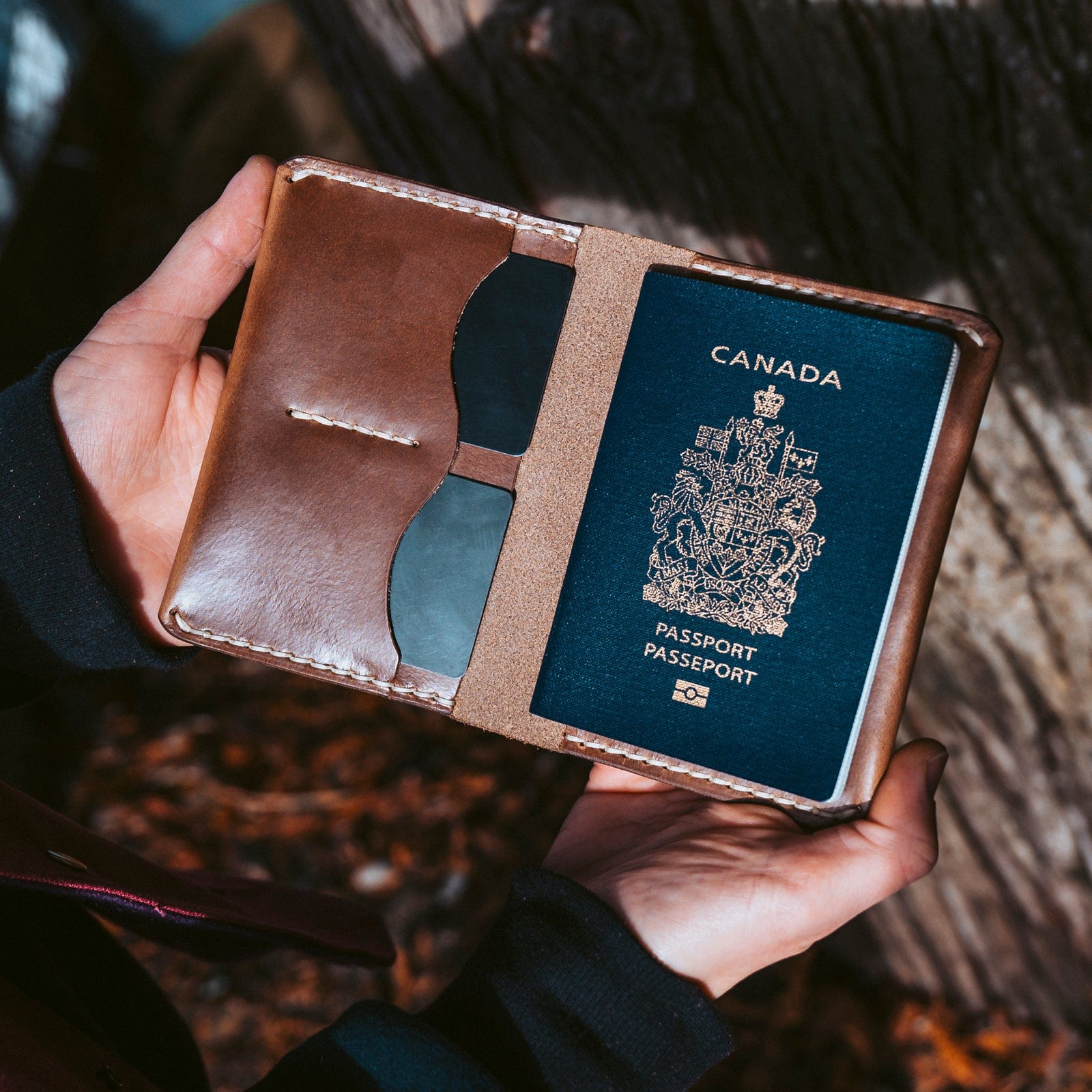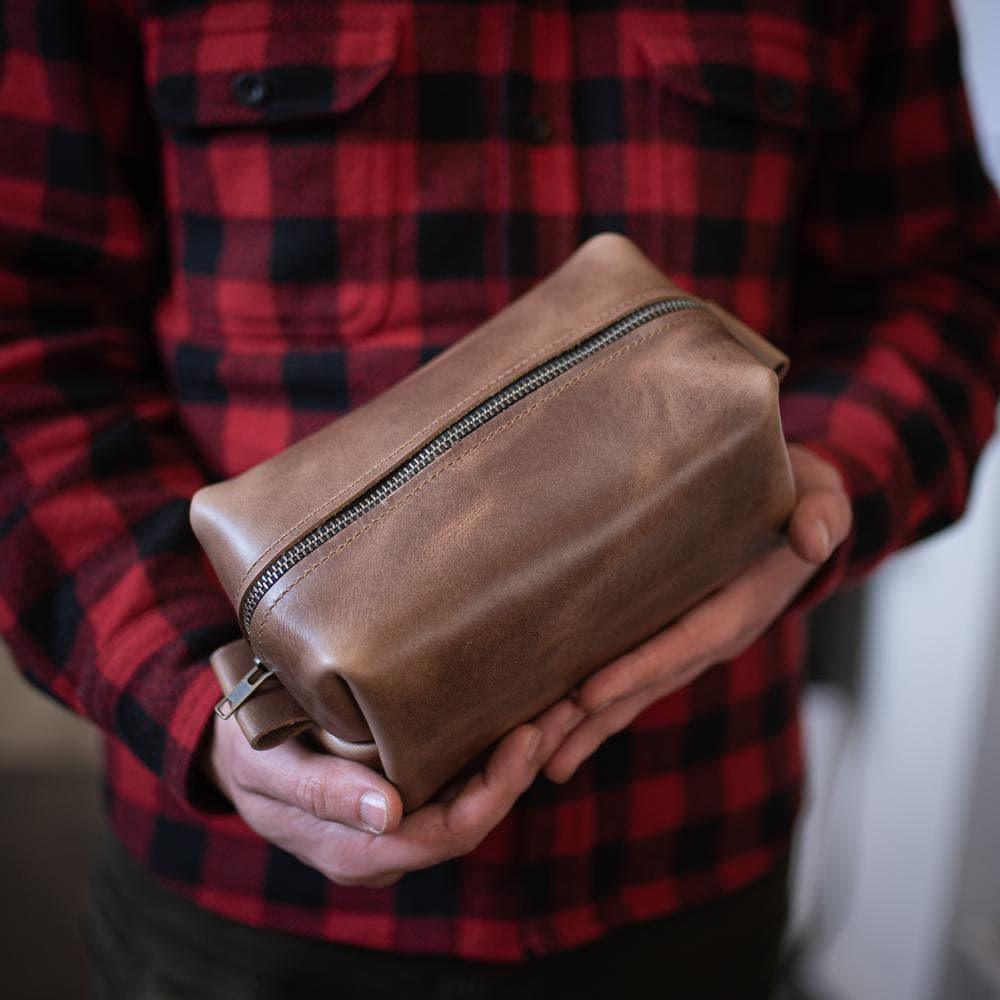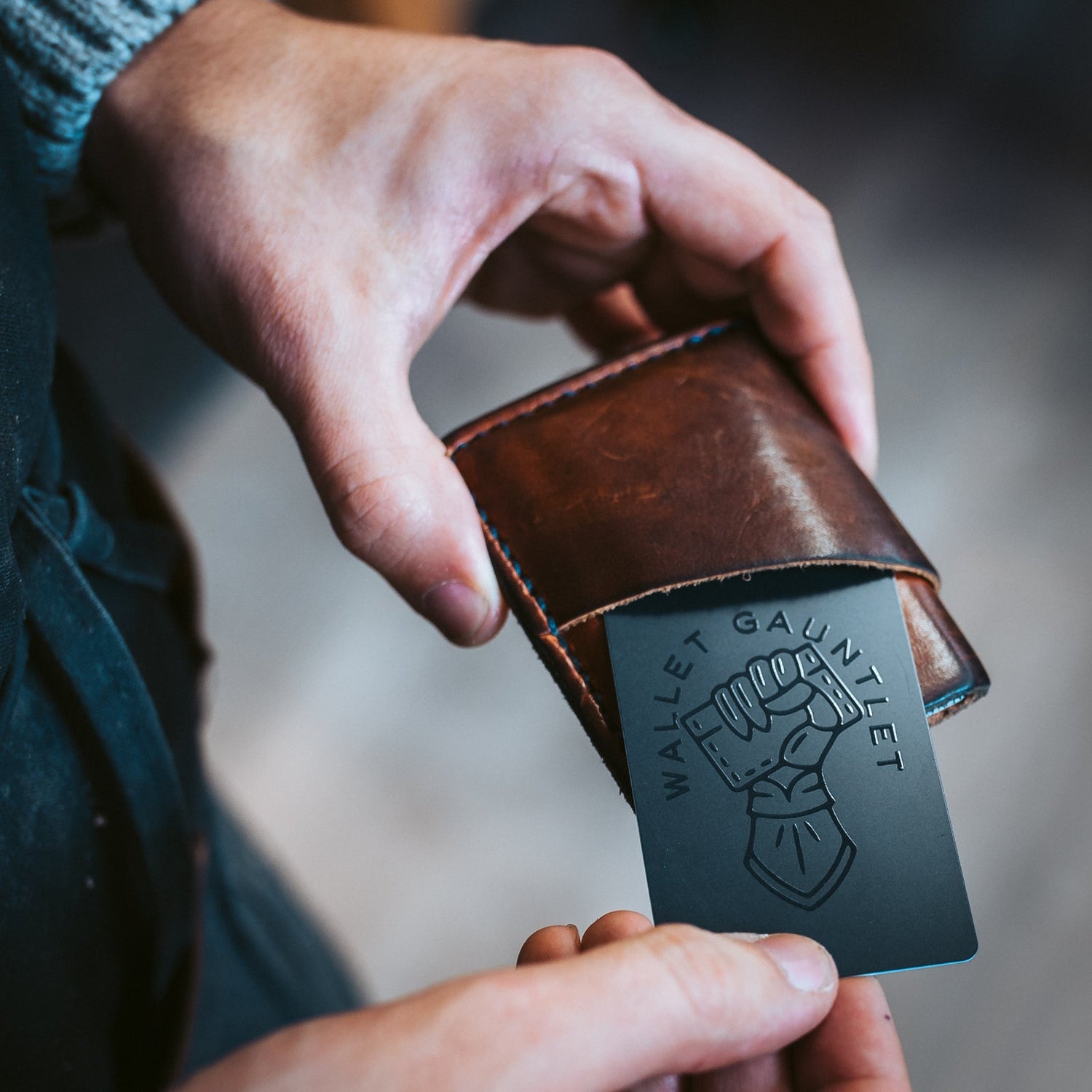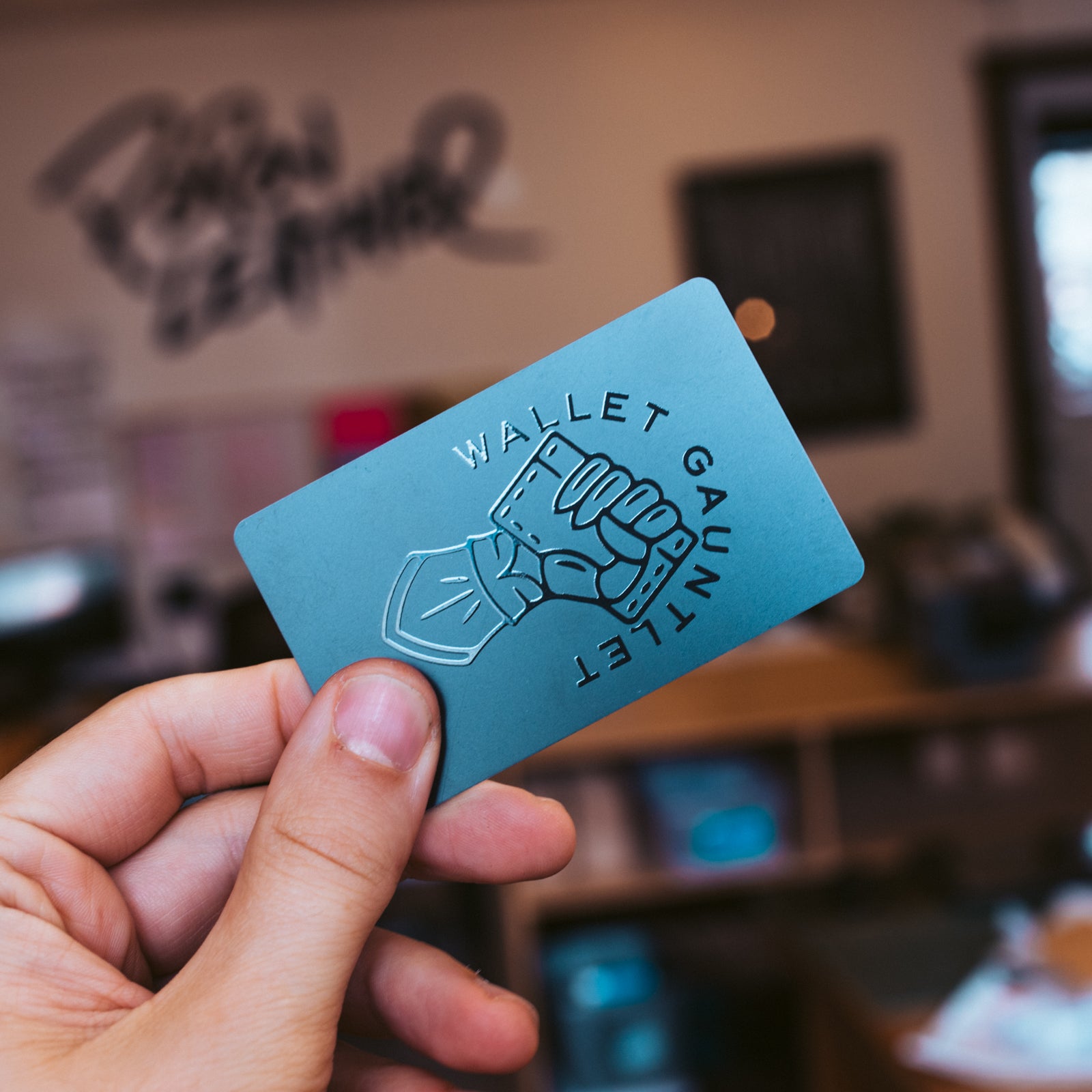RFID blocking technology keeps your credit cards secure, by operating on the principle of jamming and interference.
Today’s thieves don’t even need to touch you to steal your credit and debit card information; all they need to do is walk close to you (from a few centimeters to 10cm) with an RFID scanner.
In fact, in 20 minutes, a skilled RFID thief can gather card details from 50 cards just by walking through a busy street or shopping center.
In front or behind your credit cards? It works both sides.
Table of contents
How do you choose the best RFID blocking technology?
Consequently, developers have created numerous RFID-blocking products to protect sensitive information. However, they don't make RFID-blocking technology equal.
There are two major types of RFID-blocking technology: passive blocking and active blocking.
Using a passive RFID blocker is like having a shield in front of your RFID technology. It absorbs or reflects incoming RFID signals.
Active RFID blockers, on the other hand, have an embedded microchip that actively scrambles incoming RFID signals and temporarily jams scanning technology.
Does 2025 require RFID blocking?
According to Roger Grimes, a data-driven defense evangelist at Digital Trends, he believes that RFID-blocking cards are no longer a deep necessity.
Another point of view argues that you don't need RFID blocking technology because most credit cards and debit cards are secured by your bank.
You will be reimbursed for fraudulent activity on your cards, depending on your bank's terms and conditions.
However, on the other side of the card, are several experts who disagree.
RFID blockers are essential, and recent news stories and research confirm this fact.
For example, Adrian Kingsley-Hughes from ZDNet, conducted a test on the effectiveness of this technology, and the results were positive.
If an RFID-blocking card prevents theft of your personal information, then it is a worthwhile investment.
Can you get your money back?
If your debit and credit cards are skimmed and defrauded, any reimbursement is usually time-limited, meaning that if you don’t notice the activity for more than 60 days, your financial institution is not required to reimburse you.
Additionally, it can take time for financial institutions to investigate reported credit card or debit card fraud. While that investigation is underway, those funds may be on hold.
Considering the fact that six in ten Americans don’t have an extra $500 for an emergency, the idea of large chunks of money being out of your reach for periods of time can be a big deal for some families.
Finally, if thieves steal your card information, you may need to wait for the bank to post a new card to your home address before you make purchases. This is not always convenient when you are traveling overseas.
While this is one reason we recommend cash as one of your key EDC everyday carry items, 50% of Americans report regularly not carrying cash with them when they leave the house.
Add the inconvenience of not having cash with the possibility of needing to switch information around for all of the institutions where you have autopay enabled, and it becomes clear that preventing your information from being stolen in the first place can save you a lot of time, headache, and frustration.
The likelihood of someone maliciously skimming your bank cards in 2025 is small. Yet, the fact that the cost of a blocking card is minimal, makes them a cheap and easy-to-use 'insurance against potential RFID theft.
What is RFID?
RFID is an acronym that stands for Radio Frequency Identification.
It's a relatively new technology, commercialized in the 1980s, that uses radio waves to read and capture information stored on a device.
Interestingly, this technology is embedded in numerous devices, including credit cards, debit cards, passports, and contactless cards.
Microchips allow this RFID technology to work at short ranges — typically a few centimeters (up to 10cm) or inches.
Passive RFID tags don't require a battery as they receive power from the reader, which is why privacy and security are a concern.
Taking this into account, the Federal Trade Commission (FTC) noted that RFID tags pose a risk for unauthorized access in their RFID: Applications and Implications for Consumers report.
RIFD is the idea behind having chip readers for credit cards, for example, or scanners for passports.
Can RFID be hacked?
Yes. Unfortunately, RFID technology can be hacked.
It's worth noting that powerful RFID readers —with booster technology — can collect RFID information from up to one meter away, while more sophisticated hackers can collect information from up to three meters away.
This means that you could be in an airport, shopping center, or tourist market and have your information stolen from someone who’s not even close enough to touch you.
Luckily, RFID skimming from these distances uses a relatively sophisticated technology.
Most hackers who are capable of skimming RFID information from long distances are using their skills for something more complex.
Close-range skimmers still pose the greatest risk of stealing your RFID information.
What does RFID crime look like in 2025?
RFID skimming is one of the main RFID crimes in 2025.
For example, in January, five Giant Eagle grocery stores found credit card skimmers attached to pin pads.
This video shows how easy and quick it is to use RFID-scanning technology to glean credit card information.
Essentially, RFID skimming works by a person coming near you with an RFID scanner and skimming the information off your RFID microchip.
Most of the time, skimmers must get within a couple of inches of a credit card user to do this, but in crowded situations — like on a train or in an airport — people might not notice this close proximity.
Fortunately, there is a limit to the information transmitted from your RFID microchip.
For example, on credit cards, RFID chips include your card number and expiration date, but they don’t include the three security numbers on the back. This means that there’s at least a bit of a cap on what criminals can do with the information.
What is an RFID blocking card?
An RFID blocking card is a small card that you slip into your wallet next to your RFID-enabled card to prevent your information from being stolen.
Do RFID blocking cards work?
Yes. RFID blocking cards do work.
They create a protective shield around your cards that prevents unauthorized scanners from recording and stealing information stored within the chips.
RFID jamming cards are the size of typical credit cards (0.9mm thin and measures: 3 3/8" (8.5 cm) wide x 2.25" (5.4 cm) tall), and they work in an active way.
The Wallet Gauntlet is a RFID blocker for credit cards. Plastic resin forms its outer casing helping it to slip easily into any wallet pocket.
Instead of just blocking attempts to steal your information the way RFID blocking wallets do, RFID protecting cards actively scramble those attempts, jamming the scanner so hackers can’t try again.
How Do you use an RFID blocking card?
Using the Wallet Gauntlet is easy.
Our RFID blocker cards provide constant security within 2cm on either side. This makes it the perfect everyday carry wallet accessory.
All you have to do is slide it into your wallet next to your RFID-enabled credit card and you don't have to worry about hackers or skimmers getting ahold of your personal information.
When should you use RFID blocking card protectors?
You never know when someone might try to steal your information. Identity theft should always be reported to authorities if it does occur.
While RFID blocking card protectors are most important when you know you’re going to be in a crowded location — for example, traveling by train or in a crowded airport — their slim design makes it easy to incorporate them as an everyday carry item.
When you keep them in the same wallet sleeve as your credit card, you ensure you'll have it when you need it.
Which is better, RFID blocking cards or sleeves?
RFID Blockers + Wallet is the best choice. RFID Blocker + Sleeve is a bad choice.
RFID Sleeves:
- Won't fit into your wallet
- Have to be carried separately
- Glued, not stitched which means they fray and fall apart quickly
- Adds bulk to pockets, in addition to your wallet
- Inconvenient for payments as you have to remove them each time

One strategy is to use both an RFID block sleeve and a blocking card. The sleeve can serve to protect all of your cards, ensuring that you protect devices you may not know have RFID chips in them.
However some sleeves won't fit more than one card.
RFID protecting cards, which actively jam scanning devices, are much more reliable than RFID blocking wallets.
If you plan to use one over the other, the active technology on the RFID jamming card is the way to go.
Ultimately, it’s more secure than an RFID wallet and does a better job protecting your information.
Additionally, if you temporarily jam a scanner you might just slow down a skimmer and prevent other people’s information from getting skimmed as well.
Can you read RFID cards through RFID blocking wallets?
The ability to read RFID cards through an RFID-blocking wallet largely depends on the microchip's transmitted frequency.
For the most part, passive RFID blocking technology protects contactless payment cards.
However, RFID-enabled ID cards and passports have a larger reach. This means that to keep these personally-identifying documents secure, you would require the active RFID-blocking technology available in RFID-blocking cards.
The below table compares our Wallet Gauntlet RFID Blocking Card with a standard RFID blocking wallet:
| Feature/Aspect | Popov Leather Wallet Gauntlet | Standard RFID Blocking Wallet |
| Functionality | Scrambles any malicious attempt to skim data from unauthorized scans. | Built-in RFID protection for all compartments. |
| Flexibility | Can be used in any wallet, not just specific to one brand or design. | Limited to to the design and compartments of the specific wallet. |
| Size & Design | Same size as a credit card (0.9mm thin); features a matte finish with a glossy embossed design. | Varies; typically bulkier than a single card. |
| Battery Requirement | Does not require a battery; offers constant security. | Typically does not require a battery. |
What kind of RFID blocking card should you get?
There are a number of factors to look at when choosing the right card for your lifestyle.
Good RFID-blocking cards should be:
- Active, sending out a signal to jam skimming devices rather than simply reflecting them
- Conveniently sized, able to fit into your wallet or card holder alongside your ID card or credit card so you can use them as an everyday carry item
- Sold by a trusted manufacturer, so you know the card does what it says on the label
- Able to work without the use of a battery
- Works against both RFID and NFC signals
Does the orientation of the RFID blocking card affect its effectiveness?
No. The specific orientation doesn't affect the security of your debit or credit cards.
You can insert the Wallet Gauntlet into a spare slot in your wallet, front or back, upside down or not.
However, take note that for the best protection, you ought to sandwich your RFID-enabled bank cards between two RFID card protectors, or place a blocking card in the middle of all your bank cards.
This helps to ensure that portable scanners can't easily access the cards from various angles.
What’s the best RFID blocking card on the market?
Our Wallet Gauntlet is a slim, minimalist-style RFID-blocking card that easily fits into any wallet of your choice alongside your RFID-enabled credit card or ID card.
The battery-free card actively scrambles incoming RFID and NFC signals within 2cm on either side of the card, ensuring card readers can’t get your information unless you choose to take the blocker away.
This means that your card is only used when you actively take it out and choose to use it.
How to test that your RFID Blocking card is working?
You can use any mobile device with NFC scanning capabilities.
In the Google Play Store or iTunes store, download and install the app called "NFC TOOLS".
Then, try scanning any credit or debit card with RFID capabilities. And then try scanning that same card next to our Wallet Gauntlet. The data will be scrambled.
Or, simply go to your local grocery store and use a self-checkout.
When you attempt to make a payment, hold the Wallet Gauntlet over your payment card.
Wave both cards, together, over the contactless card reader. The payment card cannot be read by the self-checkout system.
Stephen K, purchased a new Popov Leather wallet as well as Wallet Gauntlet and said “I've always had an RFID wallet, so I purchasing an RFID blocking card, and I'm not looking back.”
Protect Against RFID Crime with RFID Blocking Card
As technology becomes more advanced, street theft of your bank information and personal identity becomes easier. There’s no denying the convenience and everyday-insurance afforded to consumers by RFID-enabled cards.
Our Wallet Gauntlet allows you to pay for items in a contact-free way without your card ever leaving your hand.
- On-The-Go Security: Protect your credit and debit card access from unwanted RFID scans.
- Convenient Design: Slim and fits seamlessly in any wallet, offering protection without bulk.
- Affordable Insurance: A small investment for peace of mind against potential indentity theft and fraud.
- Always on Guard: Actively scrambles and jams RFID signals, ensuring you are protected wherever you go.
However, these capabilities come with risks. RFID card protectors mitigate these risks, allowing you to enjoy the benefits of RFID technology without the inherent problems.
Written by Ryan Popoff
Ryan Popoff is the creative mind behind Popov Leather wallets, iPhone cases, belts, watch bands and journals since 2013. With a Bachelor Degree in Fine Arts, my leatherworking journey began at home. I wanted to create a simple leather wallet that could fit into my front pocket and — to my delight — it was a hit with family and friends. Hopefully you love our honest, quality leather goods too! Reach out with questions.













